Actually, modern ADC and DACs have virtually no nonlinear phase shift in the audio band, as the filtering is mostly done with internal DSP processing. Easily shown with a square wave generator and an analog oscilloscope.
A customer of mine was a real leader in DAC manufacturing and he believes that modern chip DACs are nearly perfect. He admitted that starting out they had some issues, but they have all been resolved.
It has been argued all over the internet that phase differences are inaudible, even by experts.
My ears tell me a different story entirely.
How are you sure that its the phase differences that you hear and not the frequency response changes?
5th element… that process leaves out a lot of context.
dave
Such as?
I was wondering if DSP is a valid way to test, since your signal is already has a lot of phase shift to begin with due to the ADC stage and DAC stage(if that is what you are using). Also, given most DSP do not have good ADC and DAC, the tests you're referring to is a bit of suspect.
Well in my test/system it's certainly valid. My entire music collection is digital and stored on a computer. So to start with there is no ADC involved.
The DSP/DAC unit I designed and built myself as no off the shelf solution offered what I wanted. The DSP takes in a full scale digital signal, number crunches, and then outputs a full scale digital signal relative to the highest point of amplitude of the filters contained within the channel. This then feeds into an ES9018 DAC, where it's jitter reduction circuitry is employed with a low phase noise oscillator. The DAC receives the 0dBfs relative signals from the DSP and it's internal volume control is not employed. I use CS3318, 8 channel, volume control chips for this with OPA1622 output buffers.
How are you sure that its the phase differences that you hear and not the frequency response changes?
Toole's 3rd edition, sections 4.8.1 The Audibility of Phase Shift and Group Delay, and 4.8.2 Phase Shift at Low Frequencies: A Special Case.
Basically, what he says in 4.8.1 is that you have to treat your room heavily (i.e., it is implied to this reader of his description) and select your listening position(s) carefully due to the off-axis output interacting with the room boundaries and furnishings. The wavelengths and distances involved indicate this is an area of attention to detail if you want to hear the differences with a linear phase set of loudspeakers--or even just one loudspeaker.
I can agree with this wholeheartedly in my experience. Not only do you need high directivity to keep the early reflections off the walls/ceiling/floor, but you also have to keep all acoustically reflective objects well out of the way to hear the benefits of controlled phase growth in the loudspeakers. I have heard this as an increase in speech intelligibility, ref. Griesinger.
However, section 4.8.2 is another story (low frequencies). He mentions Fincham (1985) and Craven and Gerson (1992), and an abandoned project described by Keith Howard (2006) specifically.
I can also attest to this effect personally, but note that the source music that you play is heavily affected by phase growth and HVAC/AC power noise of the recording equipment itself. The noted effect is "the bass lacks 'tightness' and becomes 'wooly'" (...which also sounds exactly like the effects of AM distortion, which is the dominant type of modulation distortion in woofers). "Phase equalization of the bass...subjectively extends the effective bass response by the order of half an octave..."
However, with recordings that have been made that are essentially pristine in terms of mastering roll-off and other "translation-sourced EQ", the effect is quite audible.
I've never liked the sound of ported boxes of any kind, and now the effect of group delay/phase growth at low frequencies is acknowledged in at least those three articles, to be audible/not desirable.
Chris
Last edited:
However, with recordings that have been made that are essentially pristine in terms of mastering roll-off and other "translation-sourced EQ", the effect is quite audible.
The test conducted above with the split/filtered and reintegrated sound files was done on HD650s. Not a difference could be heard. If anything was going to reveal the difference this would be it.
There seems to be this definition of 'quite audible' and 'night and day' differences etc, that get batted around by audiophiles, which in reality mean 'almost imperceptible' to 'I can't actually tell the difference' when a proper test is conducted.
The kind of thing where people start saying I can hear it you must be deaf etc. These aren't differences that are quite audible.
Quite audible is when you take a layman off the street, someone who has never had any interest in audio but nevertheless has excellent hearing, and he can easily tell you one thing sounds better than another. Or they can easily identify one thing from another.
If you need to be educated on how to pick up tiny, subtle, clues then it's not quite audible. And I would argue that if those cues are the only things that allow you to actually perceive any kind of difference then they aren't at all important to actual listening pleasure.
It's trivial to generate music files where phase shifts have been incorporated because when done as such the only thing that changes is the phase.
To experiment in a meaningful way with loudspeakers requires a tremendous amount of rigour in both your selection of loudspeaker drive units and scientific method. Otherwise, as Earl says above
How are you sure that its the phase differences that you hear and not the frequency response changes?
With my real world test I compared 2nd and 4th order LWR slopes. The on axis frequency responses were within 0.1dB of one another. The horizontal off axis frequency responses, or power response, were essentially identical too. The midrange driver was directivity matched to a waveguide loaded tweeter and crossed at 2500Hz so that the differences in 2nd and 4th order slopes didn't create differences due to the individual directivities of the drivers (this was measured). Individual distortion harmonics were ridiculously low for both, due to the drivers being particularly suitable.
The only thing that made any difference was the vertical off axis response. Due to the wider overlap regions, of the 2nd order filters, less energy was present (more cancellation/narrower listening window etc) within the crossover region when a spatially averaged response was taken. The 2nd order filter therefore gave an ever-so-slightly relaxed sound vs the 4th, which is exactly what you'd expect from less energy present within the 2.5kHz region.
But as I said in my previous post, how audible was this? Put it this way. If I had built two identical loudspeakers. One with 2nd order crossovers and one with 4th order crossovers and had auditioned the differences by turning the system off, getting up and physically swapping the speakers over...I would have never been able to hear it. Not in a million years.
And obviously I am talking about acoustic crossovers above, not electrical.
It's important to point out here that had I actually been forced to do this kind of test with two separate pairs of loudspeakers then my expectation bias would have rendered my findings from it completely meaningless.
As Zaph says above.
Part of the magic of this system is simply due to the fact that it's a solid LR2 design.
In the end, an LR2 design has 180 degrees of phase wrap through the crossover while an LR4 has 360 degrees.
But I would simply question, what magic? It's logical to assume that 180 degrees of phase wrap, rather than 360, is going to sound better, because less phase shift from the original recording right? That has to be good.
This is, after all, a solid, true, LR2 design. This is, in and of itself, a tricky task to accomplish. You can churn out LR4 designs all day long, but when things actually come together that allow you to make a proper LR2! Well the rare event has occurred!
These two things alone automatically make you think that the LR2 design is going to sound better. For a start it's rare, audiophiles and reviewers love this, it means it's special (hey we don't get many of these folks!), special sounds better right? Then there's the scientific reason. 180 degrees less phase shift, vs the original, compared to the work-horse LR4! Well that has to sound better too right?
That creates expectation bias. No one is immune to expectation bias and it means you think something actually sounds better, even though it doesn't. These expectation biases would have meant that I would have been perfectly happy to sit there listening to my LR2 version and smiling inside going, this is LR2, ooo excited and happy, this sounds great yay! I've just hit a holy grail, more feeling good inside. And wow doesn't this sound amazing!
Except I wasn't happy with that so I went and showed myself that it was all in my head.
The sentence in bold is extremely boring. It's dull. No one wants to learn that kind of thing. It means I should just stick to my work-horse and be happy that I can use virtually any decent tweeter and midrange/woofer combination. It means I also get far less excited about certain drivers that display a rare combination of characteristics and I did rather enjoy that...
Member
Joined 2009
Paid Member
I have been "playing" with minidsp-controlled four-way dipoles for three years now. Itis quite easy to eq each driver's response and set different xo types. Acoustic measurements controll and listening with friends is fun! Check the link in my signature.
Frequency response is the King, there is no doubt about that. Despite of staying in the linear range, different xos do sound a little different. All LR4 (acoustic) sounds very clear and clean. But LR2 or Duelund (elliptic) gives more natural and "easy to listen" sound specially to piano, acoustic guitar and violin. My guess is that this is because of less phase shift, and thus more natural reproduction of the harmonics of music instruments. This theory explains of course the naturalness of full-range speakers too.
I don't have a possibility to do FIR phase correction, that could help a lot to achieve low distortion, high spl capacity and natural sound.
Unfortunately all loudspeakers are compromises of various defaults.... but this is why loudspeaker desing is so intersting as a hobby! I am glad that I'm not a pro.
Frequency response is the King, there is no doubt about that. Despite of staying in the linear range, different xos do sound a little different. All LR4 (acoustic) sounds very clear and clean. But LR2 or Duelund (elliptic) gives more natural and "easy to listen" sound specially to piano, acoustic guitar and violin. My guess is that this is because of less phase shift, and thus more natural reproduction of the harmonics of music instruments. This theory explains of course the naturalness of full-range speakers too.
I don't have a possibility to do FIR phase correction, that could help a lot to achieve low distortion, high spl capacity and natural sound.
Unfortunately all loudspeakers are compromises of various defaults.... but this is why loudspeaker desing is so intersting as a hobby! I am glad that I'm not a pro.
Last edited:
The midrange driver was directivity matched to a waveguide loaded tweeter and crossed at 2500Hz so that the differences in 2nd and 4th order slopes didn't create differences due to the individual directivities of the drivers (this was measured).
Good post but doesn't the above negate the point of comparing crossover slopes since the difference in off axis response will dominate the differences heard? Or was the objective to show the effect of removing it?
Tests of phase on headphones don't really mean that much to me. We use more than our ears alone for perception of music.
A slowly turning phase isn't offensive. That doesn't mean we can't hear the difference.
I have had linear phase for an extended period. At the listening spot. I changed it's behaviour to follow the band pass of my speakers FR and compared those two. I did that test because the linear phase never "felt" right. It was quite easy to pick up the difference between those two. Much easier than a gradual phase shift of increasing length.
My guess is it I had the bass coming in too early playing some tracks, its result was unnatural.
Without having the phase result confirmed at the listening position within a well behaved room how do we know what are we are reacting to? Do we really know?
As soon as there's energy after the main peak (room reflections) it's going to change that phase behaviour. It's bound to change our perception too!
When I started my own quest to get linear phase I had all kinds of hopes how this would maximize my listening experience. If I'm honest, the room treatment needed to get there had a bigger effect than the linearizing of phase itself. Yet it was much easier to pick up differences between phase that was linearized and phase following the band pass behaviour of the FR curve.
So I won't completely discount the importance of phase on our perception. I am of the opinion that it does change my perception of lower notes. For it to work the room needs to allow the experience. It isn't the huge difference I had anticipated but it wasn't a complete let down either. If anything it sounds convincing and full in texture. Harmonics lining up seems to make a difference there.
Compare it to a lightening storm. If you see the flash and immediately hear (and feel) the thunder it's more scary. The immediacy of it, both felt and heard. Where the border is for phase shifts? I wouldn't know... It wouldn't sound offensive with phase rotation but would become more polite, less immediate with each turn.
I like what I have and am glad I did my own experimentation. Even if it wasn't the revelation I anticipated it would be. Even stereo cross talk has a far bigger influence on what we hear and how we perceive it. (that actually messes up the perceived FR curve at the ears)
This is the measured result (both speakers playing) at the listening position:

A slowly turning phase isn't offensive. That doesn't mean we can't hear the difference.
I have had linear phase for an extended period. At the listening spot. I changed it's behaviour to follow the band pass of my speakers FR and compared those two. I did that test because the linear phase never "felt" right. It was quite easy to pick up the difference between those two. Much easier than a gradual phase shift of increasing length.
My guess is it I had the bass coming in too early playing some tracks, its result was unnatural.
Without having the phase result confirmed at the listening position within a well behaved room how do we know what are we are reacting to? Do we really know?
As soon as there's energy after the main peak (room reflections) it's going to change that phase behaviour. It's bound to change our perception too!
When I started my own quest to get linear phase I had all kinds of hopes how this would maximize my listening experience. If I'm honest, the room treatment needed to get there had a bigger effect than the linearizing of phase itself. Yet it was much easier to pick up differences between phase that was linearized and phase following the band pass behaviour of the FR curve.
So I won't completely discount the importance of phase on our perception. I am of the opinion that it does change my perception of lower notes. For it to work the room needs to allow the experience. It isn't the huge difference I had anticipated but it wasn't a complete let down either. If anything it sounds convincing and full in texture. Harmonics lining up seems to make a difference there.
Compare it to a lightening storm. If you see the flash and immediately hear (and feel) the thunder it's more scary. The immediacy of it, both felt and heard. Where the border is for phase shifts? I wouldn't know... It wouldn't sound offensive with phase rotation but would become more polite, less immediate with each turn.
I like what I have and am glad I did my own experimentation. Even if it wasn't the revelation I anticipated it would be. Even stereo cross talk has a far bigger influence on what we hear and how we perceive it. (that actually messes up the perceived FR curve at the ears)
This is the measured result (both speakers playing) at the listening position:

Last edited:
Phase shift distorting the harmonics and thus the timbre of the instrument/sounds seems a likely outcome that could be audibleHarmonics lining up seems to make a difference there.
The test conducted above with the split/filtered and reintegrated sound files was done on HD650s. Not a difference could be heard. If anything was going to reveal the difference this would be it.
You do know that the quote that you used above has got effectively nothing to do with your particular crossover filters...and everything to do with the audibility of low frequency group delay, both in a loudspeaker/room system (i.e., not headphones in the near field) and embedded in the source music that is selected.
It helps to read carefully...if lessons are to be passed out freely on personal definitions of this and that quantity (including "quite audible")...but I'll certainly forgive the transgression.
My post on phase and group delay audibility was provided only to highlight the comment that "are you sure of FR...or phase?" as if relative phase were not audible. Nothing more.
Chris
Last edited:
I completely agree. I use a steep filter on the woofer and a shallow one on the tweeter, but the bottom line is whatever works. This idea of using "name brand" filters is absurd - especially in the electronics, because the acoustics will dominate the end result and there nothing is simple.

A combination of a steep LP on the Woofer and a shallow HP on the Tweeter is indeed what is needed to get the acoustic phases of the two drivers to overlap, when the "Tweeter" is a compression driver loaded by a relatively deep horn/waveguide (which pushes the Tweeter's acoustic centre behind the Woofer's).
And getting good inter-driver phase tracking is the #2 goal in good crossover design (#1 being getting a smooth total frequency response, of course).
Marco
Toole's 3rd edition, sections 4.8.1 The Audibility of Phase Shift and Group Delay, and 4.8.2 Phase Shift at Low Frequencies: A Special Case.
Chris
That there are aspects of phase that are audible under certain conditions is well known. I did some studies of this myself.
My point, which you did not address, is that in the car audio test that you refereed to, you are changing both the frequency response and the phase response. You did not explain how you knew what perception was due to which change.
Phase shift distorting the harmonics and thus the timbre of the instrument/sounds seems a likely outcome that could be audible
Griesinger states this as relevant, but most people who look into it find that it is a mild effect that requires very smooth and nearly linear phase response to detect. Most system are not "accurate" enough for this to be consider a major effect.
I didn't refer to a "car audio test". I referred to personal observations on those topics that coincided with the two sets of studies cited by Toole which I referenced--"scientific studies" (mainly for you) that could establish that possibility. I didn't see anyone else referencing those studies which I felt were apropos to the general subject--so I did. That's it.My point, which you did not address, is that in the car audio test that you refereed to...
Seems to be some angst on this subject--for reasons that I fail to see.
Chris
Most system are not "accurate" enough for this to be consider a major effect.
I don't dismiss the effects described by Griesinger. I believe that the subject should also include controlled directionality at the interference band(s)--without lobing--at the same time as talking about the flatness of the crossover filter-induced phase shifts. In my experience, it requires all of these things to get maximum benefit.
Chris
Good post but doesn't the above negate the point of comparing crossover slopes since the difference in off axis response will dominate the differences heard? Or was the objective to show the effect of removing it?
Yes that was exactly the point.
The 'major' difference was simply that the vertical off axis response was different in the two loudspeakers. The fact that the major difference was virtually imperceptible, unless you could swap immediately between the two, highlights that, beyond the vertical off axis affecting the tonal balance, the actual filter slopes didn't create, or destroy any so called 'magic'.
You do know that the quote that you used above has got effectively nothing to do with your particular crossover filters...and everything to do with the audibility of low frequency group delay, both in a loudspeaker/room system (i.e., not headphones in the near field) and embedded in the source music that is selected.
It helps to read carefully...if lessons are to be passed out freely on personal definitions of this and that quantity (including "quite audible")...but I'll certainly forgive the transgression.It's all just audio and hearing, anyway. World panic need not ensue.
My post on phase and group delay audibility was provided only to highlight the comment that "are you sure of FR...or phase?" as if relative phase were not audible. Nothing more.
Chris
Yeah I know that you were talking about at low frequencies and I wasn't. I was really responding to your comments on this part.
Basically, what he says in 4.8.1 is that you have to treat your room heavily (i.e., it is implied to this reader of his description) and select your listening position(s) carefully due to the off-axis output interacting with the room boundaries and furnishings. The wavelengths and distances involved indicate this is an area of attention to detail if you want to hear the differences with a linear phase set of loudspeakers--or even just one loudspeaker.
I can agree with this wholeheartedly in my experience. Not only do you need high directivity to keep the early reflections off the walls/ceiling/floor, but you also have to keep all acoustically reflective objects well out of the way to hear the benefits of controlled phase growth in the loudspeakers. I have heard this as an increase in speech intelligibility, ref. Griesinger.
The above isn't talking about bass frequencies though. Early reflections don't occur for bass frequencies in averaged sized rooms. In fact no reflections occur for bass frequencies in average sized rooms, the wavelengths are too long to reflect. What frequencies are you actually meaning?
Most people design for flat frequency response, and nothing wrong with that, except it really doesn't apply off-axis, where huge holes appear.
We were looking at this classic 8" polycone plus 1" tonight. The TDL Super Compact:
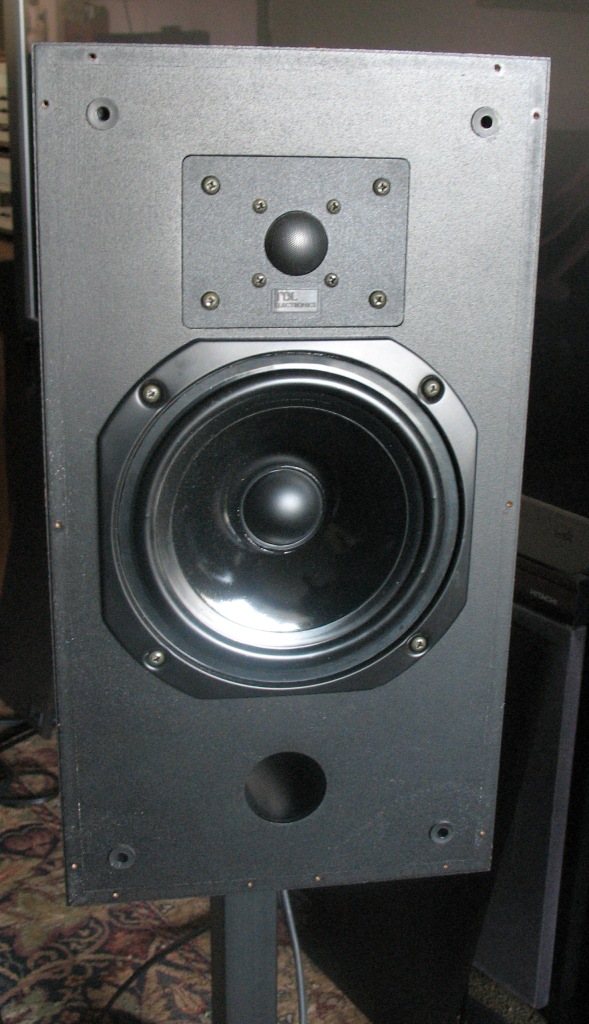
Here's a second order dotted, and second order with 6kHz breakup notch:
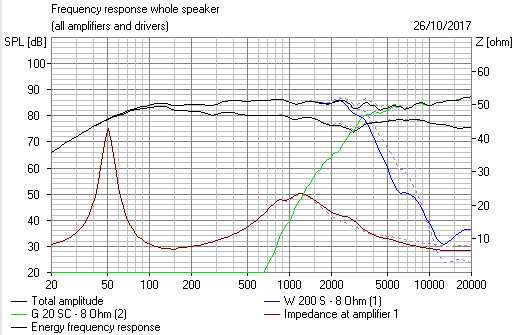
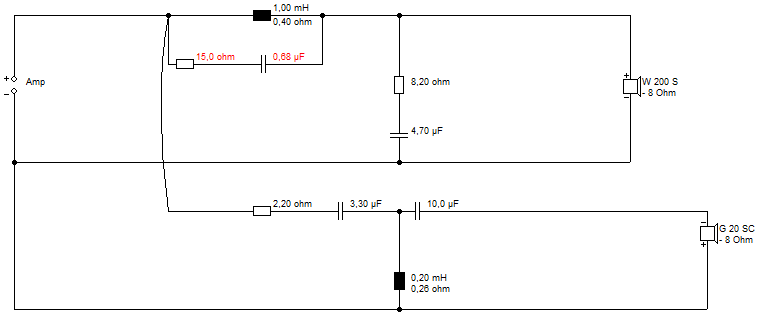
But it's a no-brainer that the third order works better:
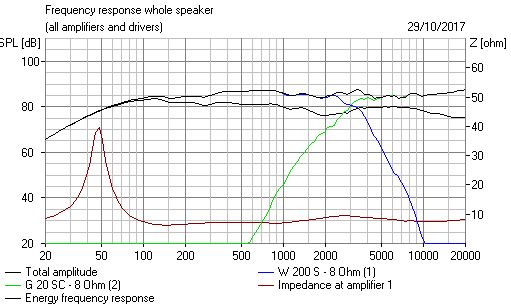
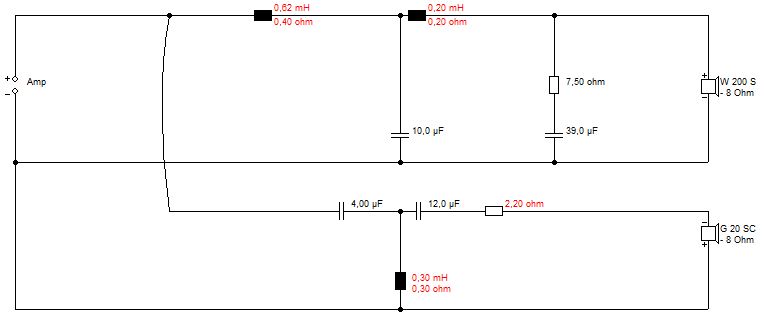
EVERYTHING is nice! Impedance and power response included.
We were looking at this classic 8" polycone plus 1" tonight. The TDL Super Compact:
Here's a second order dotted, and second order with 6kHz breakup notch:
But it's a no-brainer that the third order works better:
EVERYTHING is nice! Impedance and power response included.
Yup, this discussion opened up a big can of worms, as I expected.
My brother is also into high end audio, and has much more disposable income for tinkering and experimentation. Between my speakers and his (something like 10 different pairs), we spent a weekend fooling around with a minidsp, trying every filter option at every slope available with numerous speakers. We disconnected the built-in crossovers and went straight to amps, and tested each other to see which filters sounded the best. Even when not told which filter was being activated, we could tell when the best-sounding filter (to us) was being used... not just with one pair of speakers, but with all of them, every time. Maybe it's subtle. Maybe some training is needed to teach people to identify this characteristic that we can hear. But we can definitely hear it. Once equalization and time delay were tested and set, we both definitely thought the Bessel filters were the least-damaging to the natural-ness of the sound.
Just a reminder - the Linkwitz-Riley and Butterworth filters alter phase response; Bessel does not.
My brother is also into high end audio, and has much more disposable income for tinkering and experimentation. Between my speakers and his (something like 10 different pairs), we spent a weekend fooling around with a minidsp, trying every filter option at every slope available with numerous speakers. We disconnected the built-in crossovers and went straight to amps, and tested each other to see which filters sounded the best. Even when not told which filter was being activated, we could tell when the best-sounding filter (to us) was being used... not just with one pair of speakers, but with all of them, every time. Maybe it's subtle. Maybe some training is needed to teach people to identify this characteristic that we can hear. But we can definitely hear it. Once equalization and time delay were tested and set, we both definitely thought the Bessel filters were the least-damaging to the natural-ness of the sound.
Just a reminder - the Linkwitz-Riley and Butterworth filters alter phase response; Bessel does not.
Last edited:
- Status
- This old topic is closed. If you want to reopen this topic, contact a moderator using the "Report Post" button.
- Home
- Loudspeakers
- Multi-Way
- Well I suppose the shallow vs. steep argument will just go on and on